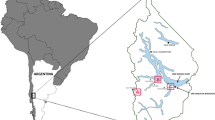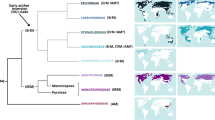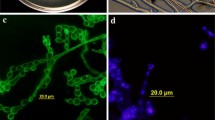Abstract
Ericaceae diversity hotspots are in the mountains of the Neotropics and Papua New Guinea, South Africa’s fynbos and Southeast Asia but majority of references to their root mycobionts come from the Northern Hemisphere. Here, typical cultivable ericoid mycorrhizal (ErM) fungi comprise Rhizoscyphus ericae, Meliniomyces variabilis, and Oidiodendron maius. It is however unclear whether this is true also for the Southern Hemisphere. Our study focused on cultivable mycobionts from hair roots of Gaultheria mucronata and Gaultheria poeppigii (Ericaceae) from two natural forests in NW Patagonia, Argentina, differing in mycorrhizal preferences of their tree dominants. We detected 62 well-defined OTUs mostly belonging to Helotiales and Hypocreales; the most frequent were Phialocephala fortinii s. l., Pochonia suchlasporia, and Ilyonectria radicicola. Only one out of 257 isolates showed ITS nrDNA similarity to members of the R. ericae aggregate (REA) but was not conspecific with R. ericae, and only five isolates were conspecific with O. maius. Microscopic observations showed that the screened roots were frequently colonized in a manner differing from the pattern typically produced by R. ericae and O. maius. A re-synthesis experiment with selected isolates showed that only O. maius formed colonization resembling ericoid mycorrhiza. Amplification of root fungal DNA with REA-specific and Sebacinaceae-specific primers showed that REA mycobionts were present in some of the screened samples while Sebacinaceae were present in all samples. These results suggest that Gaultheria spp. from NW Patagonia form ericoid mycorrhizae predominantly with the difficult-to-cultivate Sebacinaceae while the incidence of REA is relatively low and may be masked by other most likely non-mycorrhizal cultivable mycobionts.



Similar content being viewed by others
References
Agusti-Brisach C, Gramaje D, Garcia-Jimenez J, Armengol J (2013) Detection of black-foot and Petri disease pathogens in soils of grapevine nurseries and vineyards using bait plants. Plant Soil 364:5–13
Allen TR, Millar T, Berch SM, Berbee ML (2003) Culturing and direct DNA extraction find different fungi from the same ericoid mycorrhizal roots. New Phytol 160:255–272
Altschul SF, Madden TL, Schäffer AA, Zhang J, Zhang Z, Miller W, Lipman DJ (1997) Gapped BLAST and PSI-BLAST: a new generation of protein database search programs. Nucleic Acids Res 25:3389–3402
Amico GC, Aizen MA (2005) Dispersión de semillas por aves en un bosque templado de Sudamérica austral: ¿quién dispersa a quién? Ecol Aust 15:89–100
Aveskamp MM, de Gruyter J, Woudenberg JH, Verkley GJ, Crous PW (2010) Highlights of the Didymellaceae: a polyphasic approach to characterize Phoma and related pleosporalean genera. Stud Mycol 65:1–60
Berch SM, Allen TR, Berbee ML (2002) Molecular detection, community structure and phylogeny of ericoid mycorrhizal fungi. Plant Soil 244:55–66
Bergero R, Girlanda M, Bello F, Luppi AM, Perotto S (2003) Soil persistence and biodiversity of ericoid mycorrhizal fungi in the absence of the host plant in a Mediterranean ecosystem. Mycorrhiza 13:69–75
Blanchette RA, Held BW, Arenz BE, Jurgens JA, Baltes NJ, Duncan SM, Farrell RL (2010) An Antarctic hot spot for fungi at Shackleton’s Historic Hut on Cape Royds. Microb Ecol 60:29–30
Bougoure DS, Cairney JWG (2005a) Assemblages of ericoid mycorrhizal and other root-associated fungi from Epacris pulchella (Ericaceae) as determined by culturing and direct DNA extraction from roots. Environ Microbiol 7:819–827
Bougoure DS, Cairney JWG (2005b) Fungi associated with hair roots of Rhododendron lochiae (Ericaceae) in an Australian tropical cloud forest revealed by culturing and culture-independent molecular methods. Environ Microbiol 7:1743–1754
Brundrett MC (2009) Mycorrhizal associations and other means of nutrition of vascular plants: understanding the global diversity of host plants by resolving conflicting information and developing reliable means of diagnosis. Plant Soil 320:37–77
Burt, R (2004) Soil survey laboratory methods manual. Soil survey investigations report no. 42. United States Department of Agriculture, Natural Resources Conservation Service, National Soil Survey Center
Cabral A, Groenewald JZ, Rego C, Oliveira H, Crous PW (2012) Cylindrocarpon root rot: multi-gene analysis reveals novel species within the Ilyonectria radicicola species complex. Mycol Prog 11:655–688
Chambers SM, Williams PG, Seppelt RD, Cairney JWG (1999) Molecular identification of Hymenoscyphus sp. from rhizoids of the leafy liverwort Cephaloziella exiliflora in Australia and Antarctica. Mycol Res 103:286–288
Chaurasia B, Pandey A, Palni LMS (2005) Distribution, colonization and diversity of arbuscular mycorrhizal fungi associated with central Himalayan rhododendrons. Forest Ecol Manag 207:315–324
Colwell RK (2006) EstimateS: statistical estimation of species richness and shared species from samples. Version 8. User’s Guide and application published at: http://purl.oclc.org/estimates
Crous PW, Braun U, Groenewald JZ (2007) Mycosphaerella is polyphyletic. Stud Mycol 58:1–32
Curlevski NJA, Chambers SM, Anderson IC, Cairney JWG (2009) Identical genotypes of an ericoid mycorrhiza-forming fungus occur in roots of Epacris pulchella (Ericaceae) and Leptospermum polygalifolium (Myrtaceae) in an Australian sclerophyll forest. FEMS Microbiol Ecol 67:411–420
Fernando AA, Currah RS (1996) A comparative study of the effects of the root endophytes Leptodontidium orchidicola and Phialocephala fortinii (Fungi Imperfecti) on the growth of some subalpine plants in culture. Can J Bot 74:1071–1078
Fontenla S, Godoy R, Rosso P, Havrylenko M (1998) Root associations in Austrocedrus forests and seasonal dynamics of arbuscular mycorrhizas. Mycorrhiza 8:29–33
Fontenla S, Puntieri J, Ocampo JA (2001) Mycorrhizal associations in the Patagonian steppe, Argentina. Plant Soil 233:13–29
Fraser L, Turkington R, Chanway CP (1993) The biology of Canadian Weeds 102: Gaultheria shallon Pursh. Can J Plant Sci 73:1233–1247
Gardes M, Bruns TD (1993) ITS primers with enhanced specificity for basidiomycetes—application to the identification of mycorrhizae and rusts. Mol Ecol 2:113–118
Godoy R, Romero R, Carrillo R (1994) Estatus micotrófico de la flora vascular en bosques de coníferas nativas del sur de Chile. Rev Chil Hist Nat 67:209–220
Gorzelak MA, Hambleton S, Massicotte HB (2012) Community structure of ericoid mycorrhizas and root-associated fungi of Vaccinium membranaceum across an elevation gradient in the Canadian Rocky Mountains. Fungal Ecol 5:36–45
Grelet GA, Johnson D, Paterson E, Anderson IC, Alexander IJ (2009) Reciprocal carbon and nitrogen transfer between an ericaceous dwarf shrub and fungi isolated from Piceirhiza bicolorata ectomycorrhizas. New Phytol 182:359–366
Grelet GA, Johnson D, Vralstad T, Alexander IJ, Anderson IC (2010) New insights into the mycorrhizal Rhizoscyphus ericae aggregate: spatial structure and co-colonization of ectomycorrhizal and ericoid roots. New Phytol 188:210–222
Grünig CR, Queloz V, Sieber TN, Holdenrieder O (2008) Dark septate endophytes (DSE) of the Phialocephala fortinii s. l.—Acephala applanata species complex in tree roots: classification, population biology, and ecology. Botany 86:1355–1369
Gujjari P, Suh SO, Lee CF, Zhou JJ (2011) Trichosporon xylopini sp. nov., a hemicellulose-degrading yeast isolated from wood-inhabiting beetle Xylopinus saperdioides. Int J Syst Evol Microbiol 61:2538–2542
Hall TA (1999) BioEdit: a user-friendly biological sequence alignment editor and analysis program for Windows 95/98/NT. Nucleic Acids Symp Ser 41:95–98
Hambleton S, Egger KN, Currah RS (1998) The genus Oidiodendron: species delimitation and phylogenetic relationships based on nuclear ribosomal DNA analysis. Mycologia 90:854–869
Homolka L, Lisá L, Eichlerová I, Valášková V, Baldrián P (2010) Effect of long-term preservation of basidiomycetes on perlite in liquid nitrogen on their growth, morphological, enzymatic and genetic characteristics. Fungal Biol 114:929–935
Hujslová M, Kubátová A, Chudíčková M, Kolařík M (2010) Diversity of fungal communities in saline and acidic soils in the Soos National Natural Reserve, Czech Republic. Mycol Prog 9:1–15
Hutton BJ, Dixon KW, Sivasithamparam K (1994) Ericoid endophytes of Western-Australian heaths (Epacridaceae). New Phytol 127:557–566
Ishida TA, Nordin A (2010) No evidence that nitrogen enrichment affect fungal communities of Vaccinium roots in two contrasting boreal forest types. Soil Biol Biochem 42:234–243
Jones MD, Phillips LA, Treu R, Ward V, Berch S (2012) Functional responses of ectomycorrhizal fungal communities to long-term fertilization of lodgepole pine (Pinus contorta Dougl. ex Loud. var. latifolia Engelm.) stands in central British Columbia. Appl Soil Ecol 60:29–40
Kernaghan G, Patriquin G (2011) Host associations between fungal root endophytes and boreal trees. Microb Ecol 62:460–473
Kjøller R, Olsrud M, Michelsen A (2010) Co-existing ericaceous plant species in a subarctic mire community share fungal root endophytes. Fungal Ecol 3:205–214
Knapp DG, Pintye A, Kovacs GM (2012) The dark side is not fastidious—dark septate endophytic fungi of native and invasive plants of semiarid. PLoS ONE 7:E32570
Kohout P, Sýkorová Z, Bahram M, Hadincová V, Albrechtová J, Tedersoo L, Vohník M (2011) Ericaceous dwarf shrubs affect ectomycorrhizal fungal community of the invasive Pinus strobus and native Pinus sylvestris in a pot experiment. Mycorrhiza 21:403–412
Kohout P, Malinová T, Roy M, Vohník M, Jersáková J (2013) A diverse fungal community associated with Pseudorchis albida (Orchideaceae) roots. Fungal Ecol 6:50–64
Letourneau A, Seena S, Marvanová L, Barlocher F (2010) Potential use of barcoding to identify aquatic hyphomycetes. Fungal Divers 40:51–64
Lu L, Fritsch PW, Cruz BC, Wang H, Li DZ (2010) Reticulate evolution, cryptic species, and character convergence in the core East Asian clade of Gaultheria (Ericaceae). Mol Phylogenet Evol 57:364–379
Luteyn JL (2002) Diversity, adaptation, and endemism in neotropical Ericaceae: biogeographical patterns in the Vaccinieae. Bot Rev 68:55–87
Mallik AU (2003) Conifer regeneration problems in boreal and temperate forests with ericaceous understory: role of disturbance, seedbed limitation, and keystone species change. Crit Rev Plant Sci 22:341–366
Massicotte HB, Melville LH, Peterson RL (2005) Structural characteristics of root-fungal interactions for five ericaceous species in eastern Canada. Can J Bot 83:1057–1064
McLean C, Lawrie AC (1996) Patterns of root colonization in Epacridaceous plants collected from different sites. Ann Bot Lond 77:405–411
McLean CB, Cunnington JH, Lawrie AC (1999) Molecular diversity within and between ericoid endophytes from the Ericaceae and Epacridaceae. New Phytol 144:351–358
Menkis A, Allmer J, Vasiliauskas R, Lygis V, Stenlid J, Finlay R (2004) Ecology and molecular characterization of dark septate fungi from roots, living stems, coarse and fine woody debris. Mycol Res 108:965–973
Monreal M, Berch SM, Berbee M (1999) Molecular diversity of ericoid mycorrhizal fungi. Can J Bot 77:1580–1594
Moreno CE (2001) Métodos para medir la biodiversidad. M&T–Manuales y Tesis SEA, vol. 1. Zaragoza
Oliver EGH (2000) Ericaceae. In: Leister OA (ed) Seed plants of Southern Africa. National Botanical Institute, Pretoria, South Africa
Partfitt D, Hunt J, Dockrell D, Rogers HJ, Boddy L (2010) Do all trees carry the seeds of their own destruction? PCR reveals numerous wood decay fungi latently present in sapwood of a wide range of angiosperm trees. Fungal Ecol 3:338–346
Pearson V, Read DJ (1973) Biology of mycorrhiza in Ericaceae 1. Isolation of endophyte and synthesis of mycorrhizas in aseptic culture. New Phytol 72:371–379
Rains KC, Nadkarni NM, Bledsoe CS (2003) Epiphytic and terrestrial mycorrhizas in a lower montane Costa Rican cloud forest. Mycorrhiza 13:257–264
Read DJ, Leake JR, Perez-Moreno J (2004) Mycorrhizal fungi as drivers of ecosystem processes in heathland and boreal forest biomes. Can J Bot 82:1243–1263
Rodrigues A, Mueller UG, Ishak HD, Bacci M Jr, Pagnocca FC (2011) Ecology of microfungal communities in gardens of fungus-growing ants (Hymenoptera: Formicidae): a year-long survey of three species of attine ants in Central Texas. FEMS Microbiol Ecol 78:244–255
Sanchez Marquez S, Bills GF, Acuna LD, Zabalgogeazcoa I (2010) Endophytic mycobiota of leaves and roots of the grass Holcus lanatus. Fungal Divers 41:115–123
Selosse MA, Setaro S, Glatard F, Richard F, Urcelay C, Weiss M (2007) Sebacinales are common mycorrhizal associates of Ericaceae. New Phytol 174:864–878
Selosse MA, Vohník M, Chauvet E (2008) Out of the rivers: are some aquatic hyphomycetes plant endophytes? New Phytol 178:3–7
Setaro S, Weiss M, Oberwinkler F, Kottke I (2006) Sebacinales form ectendomycorrhizas with Cavendishia nobilis, a member of the Andean clade of Ericaceae, in the mountain rain forest of southern Ecuador. New Phytol 169:355–365
Sparks DL, Page AL, Helmke PA, Loeppert RH, Soltanpour PN, Tabatabai MA, Johnston CT, Sumner ME (1996) Methods of soil analysis. Part 3. Chemical Methods, Madison, Wisconsin
Upson R, Read DJ, Newsham KK (2007) Widespread association between the ericoid mycorrhizal fungus Rhizoscyphus ericae and a leafy liverwort in the maritime and sub-Antarctic. New Phytol 176:460–471
Urban A, Puschenreiter M, Strauss J, Gorfer M (2008) Diversity and structure of ectomycorrhizal and co-associated fungal communities in a serpentine soil. Mycorrhiza 18:339–354
Urcelay C (2002) Co-occurrence of three fungal root symbionts in Gaultheria poeppiggi DC in Central Argentina. Mycorrhiza 12:89–92
Usuki F, Abe JP, Kakishima M (2003) Diversity of ericoid mycorrhizal fungi isolated from hair roots of Rhododendron obtusum var. kaempferi in a Japanese red pine forest. Mycoscience 44:97–102
Vohník M, Albrechtová J (2011) The co-occurrence and morphological continuum between ericoid mycorrhiza and dark septate endophytes in roots of six European Rhododendron species. Folia Geobot 46:373–386
Vohník M, Lukančič S, Bahor E, Regvar M, Vosátka M, Vodnik D (2003) Inoculation of Rhododendron cv. Belle-Heller with two strains of Phialocephala fortinii in two different substrates. Folia Geobot 38:191–200
Vohník M, Fendrych M, Albrechtová J, Vosátka M (2007) Intracellular colonization of Rhododendron and Vaccinium roots by Cenococcum geophilum, Geomyces pannorum and Meliniomyces variabilis. Folia Microbiol 52:407–414
Vohník M, Burdíková Z, Vyhnal A, Koukol O (2011) Interactions between testate amoebae and saprotrophic microfungi in a Scots pine litter microcosm. Microb Ecol 61:660–668
Vohník M, Sadowsky JJ, Kohout P, Lhotáková Z, Nestby R, Kolařík M (2012) Novel root-fungus symbiosis in Ericaceae: sheathed ericoid mycorrhiza formed by a hitherto undescribed basidiomycete with affinities to Trechisporales. PLoS ONE 7:e39524
Vohník M, Mrnka L, Lukešová T, Bruzone MC, Kohout P, Fehrer J (2013) The cultivable endophytic community of Norway spruce ectomycorrhizae from microhabitats lacking ericaceous hosts is dominated by ericoid mycorrhizal Meliniomyces variabilis. Fungal Ecol 6:281–292
Vrålstad T, Fossheim T, Schumacher T (2000) Piceirhiza bicolorata - the ectomycorrhizal expression of the Hymenoscyphus ericae aggregate? New Phytol 145:549–563
Vrålstad T, Schumacher T, Taylor AFS (2002) Mycorrhizal synthesis between fungal strains of the Hymenoscyphus ericae aggregate and potential ectomycorrhizal and ericoid hosts. New Phytol 153:143–152
Walker JF, Aldrich-Wolfe L, Riffel A, Barbare H, Simpson NB, Trowbridge J, Jumpponen A (2011) Diverse Helotiales associated with the roots of three species of Arctic Ericaceae provide no evidence for host specificity. New Phytol 191:515–527
Wang B, Qiu YL (2006) Phylogenetic distribution and evolution of mycorrhizas in land plants. Mycorrhiza 16:299–363
Wang Z, Binder M, Schoch CL, Johnston PR, Spatafora JW, Hibbett DS (2006) Evolution of helotialean fungi (Leotiomycetes, Pezizomycotina): a nuclear rDNA phylogeny. Mol Phylogenet Evol 41:295–312
Watanabe N, Hattori M, Yokoyama E, Isomura S, Ujita M, Hara A (2006) Entomogenous fungi that produce 2,6-pyridine dicarboxylic acid (dipicolinic acid). J Biosci Bioeng 102:365–368
White TJ, Bruns TD, Lee SB, Taylor JW (1990) Amplification and direct sequencing of fungal ribosomal RNA genes for phylogenetics. In: Innis N, Gelfand D, Sninsky J, White T (eds) PCR – protocols and applications – a laboratory manual. Academic, New York, pp 315–322
Williams AF, Chambers SM, Davies PW, McLean CB, Cairney JWG (2004) Molecular investigation of sterile root-associated fungi from Epacris microphylla R. Br. (Ericaceae) and other epacrids at alpine, subalpine and coastal heathland sites. Australas Mycologist 23:94–104
Wurzburger N, Bledsoe CS (2001) Comparison of ericoid and ectomycorrhizal colonization and ectomycorrhizal morphotypes in mixed conifer and pygmy forests on the northern California coast. Can J Bot 79:1202–1210
Wurzburger N, Higgins BP, Hendrick RL (2011) Ericoid mycorrhizal root fungi and their multi-copper oxidases from a temperate forest shrub. Ecol Evol 2:65–79
Xiao GP, Berch SM (1996) Diversity and abundance of ericoid mycorrhizal fungi of Gaultheria shallon on forest clearcuts. Can J Bot 74:337–346
Zhang C, Yin L, Dai S (2009) Diversity of root-associated fungal endophytes in Rhododendron fortunei in subtropical forests of China. Mycorrhiza 19:417–423
Zhang Y, Zhang S, Wang M, Bai F, Liu X (2010) High diversity of the fungal community structure in naturally-occurring Ophiocordyceps sinensis. PLoS ONE 5:e15570
Zuloaga FO, Morrone O, Belgrano MJ, Morticorena C, Marchesi E (2008) Catálogo de la plantas vasculares del cono sur (Argentina, Sur de Brasil, Chile, Paraguay y Uruguay) Volumen 2. Missouri Botanical Garden Press, St. Louis
Acknowledgments
This study is a part of the long-term research projects of the Institute of Botany ASCR (RVO 67985939) and Universidad Nacional del Comahue (04/B143). The authors acknowledge travel stipendiums from the Ministry of Education, Youth and Sports of the Czech Republic (AMB12AR014) to M. C. Bruzone and Ministerio de Ciencia, Tecnología e Innovación Productiva de la República Argentina (ARC/11/05) to M. Vohník. We thank Dr. L. Lorenzo for her help all through our bilateral project and T. Lukešová, J. Machač, N. Fernández, M. C. Mestre, and J. J. Sadowsky for technical help. Valuable comments by Nina Wurzburger and an anonymous reviewer helped to improve an earlier version of this paper.
Author information
Authors and Affiliations
Corresponding author
Rights and permissions
About this article
Cite this article
Bruzone, M.C., Fontenla, S.B. & Vohník, M. Is the prominent ericoid mycorrhizal fungus Rhizoscyphus ericae absent in the Southern Hemisphere’s Ericaceae? A case study on the diversity of root mycobionts in Gaultheria spp. from northwest Patagonia, Argentina. Mycorrhiza 25, 25–40 (2015). https://doi.org/10.1007/s00572-014-0586-3
Received:
Accepted:
Published:
Issue Date:
DOI: https://doi.org/10.1007/s00572-014-0586-3




